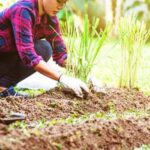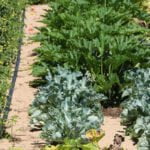As summer reaches its peak, Virginia vegetable gardeners are gearing up for a busy and productive month of August. With the warm weather and ample sunlight, this is an ideal time to tend to your vegetable garden and ensure a bountiful harvest.
Whether you’re a seasoned gardener or just starting out, there are plenty of activities and considerations to keep in mind for successful vegetable gardening in Virginia during the month of August. From planting tips to dealing with pests and disease, here’s everything you need to know to make the most of your garden this month.
August is a crucial time for planting in Virginia, with certain vegetables thriving in the late summer heat. It’s also essential to maintain and care for existing plants, while keeping an eye on weather considerations that can impact your garden. With community events and resources available for support, there are plenty of opportunities to connect with fellow Virginia vegetable gardeners and learn from their experiences.
In this article, we’ll cover everything you need to know about August vegetable gardening in Virginia. From planting recommendations to harvesting guides and tips for extending the growing season, we’ll equip you with the knowledge and tools needed for a successful and rewarding experience. Whether you’re looking to enhance your current garden or start a new one, there’s something for everyone in the vibrant world of Virginia vegetable gardening in August.
Planting Tips and Recommendations for August in Virginia
Choosing the Right Vegetables
August in Virginia can be hot and humid, so it’s important to choose vegetables that can thrive in these conditions. Some great options for planting in August include tomatoes, peppers, squash, cucumbers, and beans. These heat-loving vegetables will do well in the warm Virginia climate and will provide a bountiful harvest later in the season.
Protecting Seedlings From Heat
When planting new seedlings in August, it’s crucial to protect them from the intense summer heat. Consider using shade cloth or row covers to shield young plants from the sun’s rays. Additionally, be sure to water newly planted seedlings regularly to help them establish strong root systems before the cooler fall weather sets in.
Succession Planting
In August, consider succession planting certain vegetables to extend your harvest into the fall. For example, you can sow a new crop of lettuce or spinach every two weeks to ensure a continuous supply of fresh greens. Succession planting can help maximize your garden’s productivity and keep your dinner table stocked with fresh produce throughout the season.
By following these planting tips and recommendations for August in Virginia, you can set yourself up for a successful late-season vegetable garden. With careful planning and attention to the needs of your plants, you’ll be enjoying a bountiful harvest well into the fall months.
Maintenance and Care for Existing Vegetables in August in Virginia
In the midst of the heat and humidity of August, it’s important to provide proper maintenance and care for existing vegetables in your Virginia garden to ensure a bountiful harvest. This section will provide you with some essential tips and recommendations to keep your plants healthy and productive during this time.
Watering
One of the most crucial aspects of maintaining existing vegetables in August is ensuring they receive adequate water. With the hot summer sun beating down, plants in your garden can quickly become parched. Be sure to water deeply, allowing moisture to reach the roots. Consider watering in the early morning or late afternoon to reduce evaporation.
Weeding and Mulching
August is also a prime time for weeds to take hold and compete with your vegetables for nutrients and water. Take the time to carefully weed around your plants, being mindful not to disturb their roots. Applying a layer of mulch can help suppress weed growth while also retaining soil moisture.
Fertilization
As your vegetables continue to grow and produce, they may benefit from an extra boost of nutrients. Consider applying a balanced fertilizer according to the specific needs of each vegetable variety in your garden. However, be cautious not to over-fertilize, as this can lead to excessive foliage growth at the expense of fruit production.
By implementing these maintenance practices, you can help ensure that your existing vegetables stay healthy and robust through the challenges of August in Virginia – setting the stage for a successful harvest.
Harvesting Guide for August in Virginia
As the summer season reaches its peak in Virginia, it’s time for vegetable gardeners to start reaping the fruits of their labor. The month of August brings an abundance of fresh produce ready for harvesting. Here are some tips and recommendations for harvesting your vegetables in Virginia during this time:
1. Check for Ripeness: It’s important to regularly check your plants for ripe vegetables. Different vegetables have different indicators of ripeness, so be sure to familiarize yourself with the specific signs for each crop.
2. Harvesting Techniques: When it comes to harvesting, it’s crucial to use the proper techniques to ensure a successful harvest. For example, tomatoes should be picked when they are fully colored and slightly soft to the touch, while cucumbers should be harvested while they are still small and tender.
3. Storage and Preservation: Once you’ve harvested your vegetables, it’s important to properly store or preserve them to maintain their freshness. Some vegetables can be stored in a cool, dry place, while others may need to be preserved through canning or freezing.
4. Continuous Harvesting: In August, many vegetables such as beans, squash, and tomatoes will continue producing throughout the month. Be sure to schedule regular harvests to keep up with the continuous yield.
5. Enjoy the Bounty: Finally, don’t forget to enjoy the fruits of your labor. Whether you’re making fresh salads, canning sauces, or sharing with friends and neighbors, August is a time to savor the delicious flavors of your Virginia vegetable garden.
By following these harvesting tips and recommendations, you can make the most of your bountiful vegetable garden in Virginia during the month of August.
Dealing With Pests and Disease in August in Virginia
As August rolls around, Virginia vegetable gardeners need to be vigilant about keeping pests and disease at bay. The hot and humid weather of this month creates the perfect conditions for various insects and diseases to thrive, which can wreak havoc on your carefully tended garden.
One common pest to watch out for is the cabbage looper, which can quickly decimate brassica crops if left unchecked. Keeping an eye out for tell-tale signs of infestation, such as chewed leaves or small green caterpillars, is crucial in preventing these pests from causing widespread damage.
In addition to pests, diseases such as powdery mildew and blossom end rot can also become more prevalent in August. To prevent these issues from taking hold in your garden, it’s important to practice good sanitation by removing any affected plant material promptly and disposing of it away from the garden.
Proper watering techniques can also help reduce the likelihood of certain diseases-watering at the base of plants in the morning allows foliage to dry out during the day, reducing the risk of fungal infections.
Another effective strategy for dealing with pests and disease is to encourage natural predators and beneficial insects to take up residence in your garden. Planting nectar-rich flowers such as marigolds and cosmos can attract pollinators and predatory insects that help keep pest populations in check.
It’s also a good idea to familiarize yourself with organic methods for controlling pests and disease, such as using neem oil or insecticidal soap. These options are safer for beneficial insects, wildlife, and pets while still effectively managing pest problems. By staying proactive and informed about potential threats to your garden, you can ensure a bountiful harvest throughout August in Virginia.
| Pest/Disease | Prevention Tips |
|---|---|
| Cabbage looper | Keep an eye out for chewed leaves or small green caterpillars; use row covers; introduce natural predators like parasitic wasps |
| Powdery mildew | Practice good sanitation; water at the base of plants in the morning; remove infected plant material promptly |
| Blossom end rot | Monitor calcium levels in soil; maintain consistent watering practices; provide adequate mulch |
Weather Considerations and Tips for August in Virginia
August in Virginia brings with it hot and humid weather, which can be challenging for vegetable gardening. However, with the right weather considerations and tips, gardeners can still have a successful harvest. Here are some important factors to keep in mind when tending to your vegetable garden in August:
- Watering: With the summer heat, it’s essential to provide adequate water to your vegetables. Be sure to water deeply and consistently, especially during dry periods. Consider using soaker hoses or drip irrigation to ensure that water reaches the roots of the plants.
- Sun Protection: The intense sun in August can be detrimental to certain vegetables. Provide shade for plants that are sensitive to excessive heat, such as lettuce and spinach, by using row covers or planting them near taller crops that can offer some relief from the sun.
- Soil Care: The hot weather can cause soil moisture to evaporate quickly. Mulching is key for retaining soil moisture and preventing weeds from taking over. Refresh mulch around your plants as needed to maintain a healthy growing environment.
In addition to these weather-related considerations, there are also specific tips for maximizing your vegetable garden’s potential in August:
- Plan for Fall Crops: As summer winds down, consider planting cool-season vegetables such as broccoli, kale, and Brussels sprouts for a late-season harvest. Start seeds indoors or directly sow them into the ground later in the month.
- Protect Against Pests: The warm temperatures of August can attract unwanted pests like aphids and spider mites. Keep an eye out for signs of infestation and take proactive measures such as using insecticidal soaps or introducing beneficial insects like ladybugs to help control these pests.
- Be Mindful of Disease: Humid conditions can also create a breeding ground for plant diseases such as powdery mildew and blight. Practice good sanitation by removing any diseased plant material promptly and avoid working on wet plants to minimize the risk of spreading disease.
Tips for Extending the Growing Season in August in Virginia
Extending the growing season for your vegetable garden in Virginia can be a great way to continue enjoying fresh produce well into the fall months. By taking a few extra steps and being proactive, you can make the most of your garden even as the temperatures start to cool down. Here are some tips for extending the growing season in August in Virginia.
One effective way to extend the growing season in Virginia is by using season-extending techniques such as row covers, cold frames, or hoop houses. These methods can help protect your plants from frost and keep them thriving even as the weather changes. Additionally, planting cold-tolerant vegetables such as kale, spinach, and lettuce in August can ensure that you have a bountiful harvest well into the fall.
Another strategy for extending the growing season is to make use of mulch to retain soil warmth and moisture. Mulching around your plants can help regulate soil temperature, prevent weeds, and conserve water – all of which contribute to healthier plants that will continue producing well into the fall months.
Furthermore, consider using container gardening to bring your plants indoors once the weather starts to turn cold. This allows you to continue caring for your vegetables even as outdoor conditions become less favorable. By keeping your containers near a sunny window or under grow lights, you can continue harvesting fresh produce throughout the fall and even into early winter.
| Tips for Extending the Growing Season | August in Virginia |
|---|---|
| Utilize season-extending techniques | Row covers, cold frames, hoop houses |
| Plant cold-tolerant vegetables | Kale, spinach, lettuce |
| Use mulch to retain warmth and moisture | Helps regulate soil temperature |
Recommended Vegetable Varieties for August Planting in Virginia
When it comes to planting a vegetable garden in Virginia during the month of August, there are a variety of vegetable varieties that thrive in the warm weather and can provide a bountiful harvest. It is important to select the right vegetables for planting in August to ensure a successful and productive garden. Some recommended vegetable varieties for August planting in Virginia include tomatoes, peppers, cucumbers, summer squash, and beans.
Tomatoes are an excellent choice for August planting in Virginia due to their love of warm weather. Varieties such as cherry tomatoes, Roma tomatoes, and beefsteak tomatoes are popular choices for Virginia gardeners. Peppers, including bell peppers and hot peppers, also do well when planted in August. These heat-loving vegetables will continue to produce well into the fall months.
Cucumbers are another great option for August planting in Virginia. Varieties such as slicing cucumbers and pickling cucumbers can be planted now for a late summer harvest. Additionally, summer squash varieties like zucchini and yellow squash can be planted in August.
These fast-growing vegetables will produce an abundant harvest if planted at this time. Finally, beans such as bush beans or pole beans can also be planted now for a late season crop that will continue producing into the early fall. By selecting these recommended vegetable varieties for August planting in Virginia, gardeners can look forward to a successful late season harvest that will provide fresh produce well into the autumn months.
Overall, when considering the virginia vegetable gardening august activities to do considering these specific plants is crucial given they’ll help maintain a successful and productive garden even with difficult climate conditions that usually define this area during that time of year.
Community Events and Resources for Virginia Vegetable Gardeners in August
As the summer season starts to wind down and fall approaches, Virginia vegetable gardening enthusiasts can take advantage of a variety of community events and resources to expand their knowledge and network with fellow gardeners. Whether you are a seasoned gardener or just starting out, there are plenty of opportunities to connect with others who share your passion for growing fresh, healthy produce right in your own backyard.
Community events such as farmers markets, workshops, and gardening classes can provide valuable information and resources for Virginia vegetable gardeners in August. These gatherings offer a chance to learn from experienced growers, ask questions, and discover new techniques for maximizing your harvest during the late summer months. Additionally, many communities host seed swaps or plant sales, providing an opportunity to exchange varieties with fellow gardeners or acquire new additions for your own garden.
In addition to community events, there are a wealth of resources available for Virginia vegetable gardeners in August. Local gardening clubs and online forums can serve as valuable sources of information, offering advice on everything from pest control to soil amendments.
Public libraries often have gardening books and periodicals that can provide inspiration and guidance for improving your garden. By taking advantage of these community events and resources, Virginia vegetable gardeners can continue to enhance their skills and knowledge throughout the peak growing season.
Frequently Asked Questions
What Vegetables Can Be Planted in August in Virginia?
In August, Virginia’s gardeners can plant a variety of vegetables such as spinach, lettuce, kale, and radishes. These cool-season crops can thrive in the slightly cooler temperatures of late summer and early fall.
What Can I Plant in My Vegetable Garden in August?
August is a great time to plant heat-loving vegetables like tomatoes, peppers, eggplant, and cucumbers. These plants thrive in the warm temperatures and long days of late summer, providing a bountiful harvest before the first frost.
What Vegetables Are Ready to Harvest in August?
Vegetables that are ready to harvest in August include summer squash, zucchini, tomatoes, peppers, cucumbers, and green beans. These warm-season veggies have been growing throughout the summer months and are now reaching their peak ripeness for picking.

If you’re looking to get into vegetable gardening, or are just looking for some tips on how to make your current garden better, then you’ve come to the right place! My name is Ethel and I have been gardening for years. In this blog, I’m going to share with you some of my best tips on how to create a successful vegetable garden.





